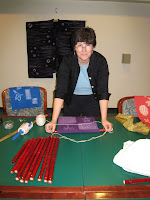
The art of
shibori can be traced to ancient times and from around the world: South America, the Middle East, India, China, Malaysia, & Japan. It made its way to North America in the 20th century, most notably as the colorful tie-dye t-shirts from the era of the Grateful Dead. There are many ways of creating
shibori: by clamping, folding, tying, twisting or pressing the fabric before you dye it.
Shibori master Yoshiko Wada translates
shibori to mean “wring, squeeze or press” or “shaped-resist dyeing,” what we in America might call an aesthetic tie-dye.
When I create my loom-controlled
shibori, I work with both silk and cotton and right now I'm weaving with silk noil. When you wash the fabric after it is dyed, the noil has this light, airy hand that is lucious to feel. I've just warped up another 9 yards of silk noil. I've been doing my
noren, but the next group will be shawls, becasue it feels so good next to your body.
I've been attracted to Japanese textiles for years and as I've been developing my weaving skills, I've become inspired by a particular and practical form of Japanese domestic textile, called
noren, which is traditionally used to mark an entrance or as a room divider.
 Noren’s
Noren’s use is not only practical, it also welcomes one to a place of beauty. I like the idea of having fabric hanging in the home that is there just to be beautiful. The long panels of the
noren are a wonderful display place for my
shibori. The second loom-controlled
shibori piece I did was based upon a
noren I have in my home.

Right now I’m in a whimsical stage drawing my motifs as the Japanese do, from nature. I'm creating my version of
shibori insects, leaves and flowers in a range of colors. The dyeing is key--I'll do another blog about that process soon.















 a thread!
a thread!













